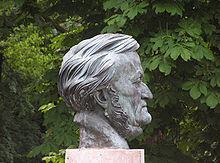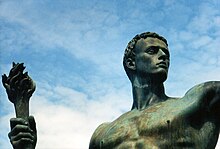Arno Breker
Arno Breker | |
|---|---|
 Breker in the 1930s | |
| Born | 19 July 1900 |
| Died | 13 February 1991 (aged 90) Düsseldorf, Germany |
| Alma mater | Kunstakademie Düsseldorf |
| Known for | Sculpting |
| Olympic medal record | ||
|---|---|---|
| Art competitions | ||
| 1936 Berlin | Statues | |
Arno Breker (19 July 1900 – 13 February 1991) was a German sculptor who is best known for his public works in Nazi Germany, where they were endorsed by the authorities as the antithesis of degenerate art. He was made official state sculptor, and exempted from military service.[1] One of his better known statues is Die Partei, representing the spirit of the Nazi Party that flanked one side of the carriage entrance to Albert Speer's new Reich Chancellery.
After the fall of Nazi Germany in 1945 Breker continued to thrive professionally as a sculptor in the new West Germany.[1]
Life
[edit]Breker was born in Elberfeld, in the west of Germany, the son of stonemason Arnold Breker.[2] He began to study architecture, along with stone-carving and anatomy. At age 20 he entered the Düsseldorf Academy of Arts where he concentrated on sculpture, studying under Hubert Netzer and Wilhelm Kreis.[3] He first visited Paris in 1924, shortly before finishing his studies. There he met with Jean Cocteau, Jean Renoir, Pablo Picasso, Daniel-Henry Kahnweiler, and Alfred Flechtheim.[3] In 1927 he moved to Paris, which he thereafter considered to be his home, in the same year he had an exhibition with Alf Bayrle. Breker was quickly accepted by the art dealer Alfred Flechtheim. He also established close relationships with important figures in the art world, including Charles Despiau, Isamu Noguchi, Maurice de Vlaminck and André Dunoyer de Segonzac, all of whom he later portrayed. He travelled to North Africa, producing lithographs which he published under the title "Tunisian Journey". He also visited Aristide Maillol, who was later to describe Breker as "Germany's Michelangelo".[citation needed]

In 1932, he was awarded a prize by the Prussian Ministry of Culture, which allowed him to stay in Rome for a year. In 1934 he returned to Germany on the advice of Max Liebermann. At this time Alfred Rosenberg, editor of the Nazi newspaper Völkischer Beobachter, actually denounced some of Breker's work as degenerate art. However, Breker was supported by many Nazi leaders, especially Adolf Hitler. Even Rosenberg later hailed his sculptures as expressions of the "mighty momentum and will power" ("Wucht und Willenhaftigkeit") of Nazi Germany.[4] He took commissions from the Nazis from 1933 through 1942, for example participating in a show of his work in occupied Paris in 1942, where he met Jean Cocteau, who appreciated his work. He maintained personal relationships with Albert Speer and with Hitler. In 1936 he won the commission for two sculptures representing athletic prowess, to be entered in the 1936 Olympic games arts competition in Berlin, one representing a Decathlete ("Zehnkämpfer"), which won the silver medal for statues, and the other The Victress ("Die Siegerin").[5] In 1937 he married Demetra Messala (Δήμητρα Μεσσάλα), a Greek model. The same year, Breker joined the Nazi Party and was made "official state sculptor" by Hitler, given a large property and provided a studio with forty-three assistants.[6][1] Breker was on a list of 378 "Gottbegnadeten" (divinely gifted) artists exempted from wartime military duty by Hitler and chief propagandist Joseph Goebbels. His twin sculptures The Party and The Army held a prominent position at the entrance to Albert Speer's new Reich Chancellery, as well as Josef Thorak's "Striding Horses" (1939), which until 1945 flanked the entrance stairs on the garden front of Adolf Hitler's Reich Chancellery in Berlin.[1]
The neoclassical nature of his work, with titles like Comradeship, Torchbearer, and Sacrifice, typified Nazi ideals, and suited the characteristics of Nazi architecture. On closer inspection, though, the proportions of his figures, the highly colouristic treatment of his surfaces (the strong contrasts between dark and light accents), and the melodramatic tension of their musculatures perhaps invites comparison with the Italian Mannerist sculptors of the 16th century. This Mannerist tendency to Breker's neoclassicism may suggest closer affinities to concurrent expressionist tendencies in German Modernism than is acknowledged.[citation needed]
Until the fall of the Third Reich, Breker was a professor of visual arts in Berlin.
Post-Nazi career
[edit]Ninety percent of Breker's public works were destroyed during the bombings of Germany toward the end of the war.[7] In 1946, Breker was offered a commission by Soviet leader Joseph Stalin, but he refused, saying "One dictatorship is sufficient for me".[8] In 1948 Breker was designated as a "fellow traveller" of the Nazis and fired, despite which he continued to thrive professionally.[1] He returned to Düsseldorf, now in the new West Germany, which remained his base, with periods of residence in Paris. During this time he worked as an architect. However, he continued to receive commissions for sculptures, producing a number of works in his familiar classical style, working for businesses and individual patrons. He also produced many portrait busts. In 1970 he was commissioned by the king of Morocco to produce work for the United Nations Building in Casablanca, but the work was destroyed. Many other works followed, including sculptures for Dusseldorf's city hall, portraits of Anwar Sadat and Konrad Adenauer, and a statue of Pallas Athene, helmeted and throwing a spear in the same bombastic style as his Nazi-era work.[1] Breker's rehabilitation continued, culminating in the creation of a Breker museum, funded by the Bodenstein family, who set aside Schloss Nörvenich (between Aachen and Cologne) for the purpose. The Arno Breker Museum was inaugurated in 1985, and still open in 2021.[1]
Breker's rehabilitation led to backlashes from anti-Nazi activists, including controversy in Paris when some of his works were exhibited at the Centre Georges Pompidou in 1981.[1] In the same year anti-Breker demonstrations accompanied an exhibition in Berlin. Breker's admirers insisted that he had never been a supporter of Nazi ideology, but had simply accepted their patronage.[citation needed]
Breker's last major work was a monumental sculpture of Alexander the Great intended to be located in Greece.[citation needed]
Marriages and family
[edit]Arno Breker was married twice. His first wife, Demetra Messala, was a Greek model. She died in 1956 in a car accident. He remarried in 1958 to Charlotte Kluge. They had two children, Gerhart (1959) and Carola (1962). Breker remained married to Kluge until his death in 1991.[9]
Portraits (mostly in bronze)
[edit]


|
|
|
Sculptures 1935–1945
[edit]
- Prometheus (1935)
- Relief am Gebäude der Lebensversicherung Nordstern, Berlin (1936)
- Der Zehnkämpfer fürs Olympia-Stadion, Berlin (1936, Silver medal)
- Die Siegerin fürs Olympia-Stadion, Berlin (1936)
- Dionysos fürs Olympia-Dorf, Berlin (1936)
- Der Verwundete (1938)
- Der Rosseführer (1938)
- Anmut (1938)
- Fackelträger („Die Partei") im Hof der Neuen Reichskanzlei (1939)
- Schwertträger („Die Wehrmacht") im Hof der Neuen Reichskanzlei (1939)
- Schreitende Pferde, Gartenfront, Neue Reichskanzlei (1939)
- Der Künder (1939)
- Der Wäger (1939)
- Bereitschaft (1939)
- Der Rächer (1940)
- Kameraden (1940), Breker-Museum
- Bannerträger (1940)
- Abschied (1940)
- Vernichtung (1940)
- Opfer (1940)
- Schreitende (1940)
- Der Wächter (1941)
- Psyche (1941)
- Berufung (1941)
- Der Sieger (1942)
- Kniende (1942)
- Eos (1942)
- Flora (1943)
- Heros (1943)
Reliefs
[edit]
|
|
Books by Breker
[edit]- 1983 – Schriften ("Writings") Bonn: Marco-Edition ISBN 3-921754-19-4.
- 1987 – Begegnungen und Betrachtungen ("Encounters and Reflections") Bonn: Marco-Edition ISBN 3-921754-27-5.
- 2000 – Über allem Schönheit ("Above All Beauty") Arnshaugk. ISBN 3-935172-02-8
Films and videos
[edit]- Arno Breker – Harte Zeit, starke Kunst, by Arnold Fanck, Hans Cürlis, Riefenstahl-Film GmbH, Berlin (1944)
- Arno Breker – Skulpturen und Musik, by Marco J. Bodenstein, 20 minutes, Marco-Edition Bonn.
- Arno Breker – Deutsche Lebensläufe, Farbfilm 60 minutes, Marco-VG, Bonn.
- Paris-Rom-Berlin und Arno Breker, and Interview with Albert Speer. Farbfilm, 60 minutes, EKS Museum Europäische Kunst, Schloss 52388 Nörvenich.
- Zeit der Götter (1992)[11]
See also
[edit]References
[edit]Notes
- ^ Jump up to: Jump up to: a b c d e f g h Jeffries, Stuart (7 September 2021). "Hitler's favourite artists: why do Nazi statues still stand in Germany?". The Guardian.
- ^ "Arno Breker: Bildhauer, Graphiker, Architekt". Deutsches Historische Museum. Retrieved 11 September 2011.
- ^ Jump up to: Jump up to: a b Steinbach, Werner. "Biographie". Museum Arno Breker. Retrieved 18 September 2011.
- ^ Caroline Fetscher, "Why Mention Arno Breker Today?", The Atlantic Times, August, 2006. Archived 11 February 2012 at the Wayback Machine
- ^ "Arno Breker". Olympedia. Retrieved 29 July 2020.
- ^ Evans, Richard, "The Third Reich in Power", New York: Penguin Books, 2005, p. 167.
- ^ Landler, Mark (24 July 2006). "'Hitler's Favorite Sculptor' Is Back, Hitting Raw Nerve". The New York Times. Retrieved 22 April 2023.
- ^ Evans, Richard J. The Third Reich at War. New York: Penguin 2008, p. 754
- ^ Arno Breker biography
- ^ Kraus & Obermair 2019, pp. 38–39.
- ^ "Overview" The New York Times
Further reading
- Bodenstein, Joe F. (2016). Arno Breker – une biographie. Paris: Èditions Séguier Paris. ISBN 978-2-84049-690-8
- Despiau, Charles (1942). Arno Breker. Paris: Edition Flammarion.
- Egret, Dominique (1997). Arno Breker: Ein Leben für das Schöne. Berlin: Grabert Verlag. ISBN 3-87847-157-2.
- Hirlé, Ronald (2010). Arno Breker – Sculpteur – Dessinateur – Architecte. Strasbourg and Paris: Editions Hirlè. ISBN 978-2-914729-83-3
- Klier, Hans (1978). Arno Breker – Form und Schönheit. Bonn: Salzburger Kulturvereinigung; Paris: Marco-Edition.
- Kraus, Carl; Obermair, Hannes (2019). Mythen der Diktaturen. Kunst in Faschismus und Nationalsozialismus – Miti delle dittature. Arte nel fascismo e nazionalsocialismo. Landesmuseum für Kultur- und Landesgeschichte Schloss Tirol. ISBN 978-88-95523-16-3.
- Leber, Hermann (1998). Rodin, Breker, Hrdlicka ISBN 3-487-10722-8
- Möller, Uwe (2000). Arno Breker – Zeichnungen-Drawings-Dessins 1927–1990. Bonn: Marco Edition ISBN 3-921754-37-2
- Peyrefitte, Roger (1980). Hommage an Arno Breker. Paris: Marco-Edition. ISBN 3921754097
- Probst, Volker G. (1981). Der Bildhauer Arno Breker – Eine Untersuchung. Paris: Marco-Edition ISBN 3-921754-07-0.
- Probst, Volker G. (1981). Das Bildnis des Menschen im Werk von Arno Breker Paris: Marco-Edition. ISBN 3-921754-13-5.
- Probst, Volker G. (1985). Das Pietà-Motiv bei Arno Breker. Paris: Marco-Edition. ISBN 3-921754-25-9
- Schilling, Rolf (1994). Eros und Ares – Begegnung mit Breker. Munich: Edition Arnshaugk ISBN 3-926370-21-1
- Trimborn, Jürgen (2011). Arno Breker. Der Künstler und die Macht. Berlin: Aufbau-Verlag ISBN 978-3-351-02728-5
- Zavrel, B. John (1985). Arno Breker – His Art and Life. New York: West Art. ISBN 0-914301-01-2
- Zavrel, B. John and Ludwig, Peter (1990). Arno Breker – The Collected Writings. New York: West Art; Paris: Marco-Edition. ISBN 0-914301-13-6
- Zavrel, B. John and Webb, Benjiman D. (1982). Arno Breker – The Divine Beauty in Art. New York: West Art. ISBN 0-914301-04-7
External links
[edit]- Web museum
- Interview with Arno Breker conducted in 1979
- Arno Breker Museum Official Site (in German)
- Arno Breker Biography (in German)
- Arno Breker Life, Work and Relationships with Modern Writers and Artists (in French)[permanent dead link]
- Demetra Messala Article about Arno Breker's wife
- Arno Breker Appreciation Group
- 1900 births
- 1991 deaths
- People from Elberfeld
- Nazi Party politicians
- German modern sculptors
- Artists from the Rhine Province
- Olympic silver medalists in art competitions
- 20th-century German sculptors
- 20th-century German male artists
- German male sculptors
- Medalists at the 1936 Summer Olympics
- Olympic competitors in art competitions
- Architects from Wuppertal